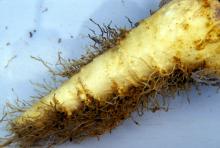By O. Neher and C. M. Ocamb
Cause Heterodera schachtii is a sedentary endoparasite with a relatively small host range. Other crop hosts are mangel-wurzel, table beet, cabbage, cauliflower, Brussels sprouts, broccoli, rape, turnip, rutabaga, and radish. Weed hosts are dock, knotweed, lambsquarters, mustard, nightshade, purslane, saltbush, and red root. Any of these that overwinter may be reservoirs for the pests and may counteract much of the value of crop rotation.
Symptoms Beets are stunted in small, conspicuous areas of the field. Infected beets are much smaller than normal ones. Often, they have a dense system of secondary roots called hairy-root condition. Use a hand lens to examine rootlets and the tap root; usually you can see numerous small, white, bead-like or lemon-shaped structures that later become egg cysts. Pull dwarfed beets that tend to wilt in warm weather and examine them for small, white, bead-like females. Later in the season, areas of nematode infestation often are marked by absence of beets and presence of weed patches.
Sampling Infective second-stage juveniles, adult males (rarely), and cysts (the dead body of the female, which contains eggs) can be obtained from the soil samples.
A simple field test for nematodes is to place a teaspoonful of soil in a glass of water, stir briefly, allow debris to float to the surface, and look for brownish cysts adhering to the side of the glass. This test will not indicate severity of infestation but show that the field has a nematode history.
Cyst extraction requires a special extraction procedure. If a cyst count is desired, note that on the form accompanying the sample. During the growing season, it is helpful to send roots as well as soil to assist the diagnosis. Before planting sugar beets, take soil samples with sufficient lead time to implement management procedures if necessary. For example, after soil fumigation, it may be several weeks before crops can be planted. Fall sampling for crops to be planted the following spring is an excellent strategy.
Cultural control
- Use a 3- to 6-year crop rotation. Slight infestations may require only a 2-year interval, but severe infestations require a 5- to 6-year interval. Crops that may be in a short-term rotation are beans, sweet clover, corn, grains, peas, potatoes, and tomatoes. Alfalfa is suitable for a long rotation period.
- Use fumigant, catch, or non-host crops to reduce infestation.
- Do not return tare dirt to fields.
- Plant tolerant varieties.
- Practice good weed control including removing volunteer hosts in non-beet fields.
Chemical control
- Fumigate soil before planting. Telone II at 18 gal/A broadcast on mineral soils. Restricted-use pesticide. Wait 2 to 3 weeks after applying before planting, or until odor leaves the soil. Do not treat extremely heavy soils. 5-day reentry.
Biological control
- MeloCon WG at 6 to 9 lb/A as an in-furrow application at planting for nematode suppression. 4-hr reentry. O


